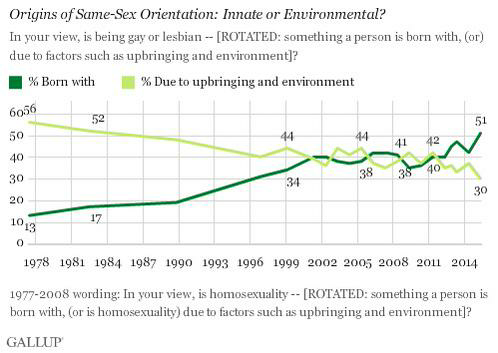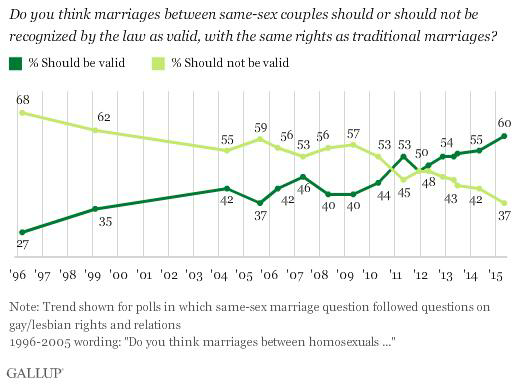On June 26, 2015, Justice Kennedy, writing for the majority in a 5-4 decision held that state laws banning same sex marriage violated the 14th amendment to the Constitution, and additionally (although less reported in the media) States without same sex marriage who fail to recognize marriages in other states violates the full faith and credit clause of Article IV of the United States constitution. Justices Kennedy, Ginsberg, Breyer, Kagan, and Sotomayor were in the majority. Justices Scalia, Roberts, Thomas and Alito dissented. This article details a brief history and background of some of the important issues involved, and an analysis of how the respective majority and minority voted and why.
Background
A little background is necessary to understand the complexities of the same sex marriage issue. The United States Constitution is made up of Articles which detail the responsibilities of government, and amendments which detail the right of the people.
I. OUR RIGHTS: The founding fathers struggled over how to present our rights in the Constitution. Some founding fathers wanted each right of the people spelled out in clear detail (ex, Thomas Jefferson). Other founding fathers wanted to not list any rights in the Constitution and reserve for society decide what those rights are (ex, Alexander Hamilton, James Madison). The fear was listing some rights and not others would be perceived as limiting people only to the rights listed. As a result, a compromise was reached where certain basic rights were listed, but the people reserved the right to identify other rights over time. Jefferson’s famous quote was “Half a loaf is better than no bread. If we cannot secure all our rights, let us secure what we can.” This debate about listing or not listing rights was so contentious that it became the reason why the bill of rights was added as amendments and not part of the original constitution. The following link are actual letters between Jefferson and Madison on this issue: http://teachingamericanhistory.org/bor/madison-jefferson1/
II. CONSTITUTIONAL INTERPRETATION: In the 225+ years since the passage of our Constitution, the debate over rights has not subsided. Interpreting the he Constitution can be broken down into two camps, the strict Constructionists and the Living Document approach.
Strict Constructionists, such as Justices Scalia, Thomas, Roberts, and Alito, believe that the Constitution is to be strictly interpreted. If the right is not listed in the Constitution, then it doesn’t exist. This is a valid point based on the idea that if judges could find whatever they want in the Constitution, then there is no need for a legislature which is chosen by the people. However, it also runs contrary to the intentions of the founding fathers, and discounts the fact that rights are different than laws. The legislature defines our laws, the Constitution defines our rights.
Living Breathing Document. At the opposite end of strict construction is the living breathing document approach. This is centered around the idea that the Constitution is a living document that can be fluidly interpreted to meet the needs of an evolving society. The Constitution is often ambiguous and undefined in terms of reasonableness. Courts have the power to further define and interpret the Constitution as society changes. This is also a valid point, and the belief of the more liberal justices such as Ginsberg, Sotomayor, Breyer, and Kagan. There is strong evidence for this approach in the writings of the founding fathers. However, there always remains a concern that overreaching interpretation would remove the need and purpose of a legislature.
III. The 14th Amendment. The 14th amendment was not part of the original Constitution or bill of rights. It was passed and ratified in the late 1860s as part of the reparation package to mend from the destruction of the Civil War and slavery. Although not part of the original plan of the founding fathers, it is just as valid and remains the cornerstone of today’s jurisprudence. The 14th amendment is an ungodly, long winded amendment, but the pertinent parts for our purposes are “No State shall make or enforce any law which shall abridge the privileges or immunities of citizens of the United States; nor shall any State deprive any person of life, liberty, or property, without due process of law; nor deny to any person within its jurisdiction the equal protection of the laws”
The due process and equal protection language has been the subject of much debate and court interpretation in the 150+ years since it’s passing. The 14th amendment has become the legal justification that courts use to find “other rights and protections” which are not specifically listed in the Constitution.
These are the more significant cases by the Supreme Court on the 14th Amendment:
- RIGHT TO PRIVACY (Griswold v Connecticut 1965). The state of Connecticut had a law that made it a crime to use contraception by married people. Connecticut used the law to prosecute planned parenthood clinics for distributing contraception. The Supreme Court held that a Right to Privacy exists in the 14th amendment under the liberty language.
- RIGHT TO ABORTION (Roe v Wade 1973). The Supreme Court held that, under the right to privacy, a woman has the right to an abortion under the 14th amendment, but subject to certain restrictions.
- NO RIGHT TO ASSISTED SUICIDE (Washington v Glucksberg 1997). There is no right to assistance in committing suicide under the 14th amendment. Unanimous decision.
- RIGHT TO SEXUAL PRIVACY (Lawrence v Texas 2003). Texas had a law criminalizing sodomy. The Supreme Court held that a right to sexual privacy exists under the 14th amendment. Scalia and Thomas also dissented in this case as well.
- RIGHT TO EQUAL PROTECTION. Perhaps the biggest line of cases are the equal protection cases originating from the 14th amendment. Every citizen has the right to be treated equally under the law. As such, Segregated schools are unconstitutional (Brown v Board of Education), excluding women from a military school is unconstitutional (US v Virginia), banning use of contraception by unmarried people is unconstitutional (Eisenstadt v Baird), and banning non whites from sitting on juries is unconstitutional (Hernandez v Texas).
- GAY RIGHTS. Over the past 25 years, there have been a number of cases defining Gay Rights under both the Liberty and Equal protection language of the 14th Amendment:
- Romer v Evans, 1996. A Colorado law forbidding protected status for gays is unconstitutional. Gays may sue for discrimination. (Kennedy, Ginsberg, Breyer in majority, Scalia and Thomas dissented)
- Lawrence v Texas, 2003. Texas law criminalizing Sodomy is unconstitutional (Kennedy, Ginsberg, Breyer in majority, Scalia and Thomas dissented)
- US v Windsor 2013, Federal Defense of Marriage Act (DOMA) is unconstitutional and the Federal Government must recognize same sex marriages which were valid in certain states (Same majority and dissent as in Obergefell)
V. Marriage Equality. The most famous equal protection case, as it pertains to marriage equality, is Loving vs Virginia, 1967. Virginia and many southern states (17) had a law criminalizing marriages between whites and blacks (known as Anti-miscegenation laws). Loving pled guilty was sentenced to 1 year probation. Chief Justice Earl Warren wrote in his decision which overturned the statute:
“Marriage is one of the basic civil rights of man, fundamental to our existence and survival…To deny this fundamental freedom on the basis [of race] is so directly subversive of the principle of equality at the heart of the 14th amendment, and surely deprives citizens of liberty without due process of law. The 14th Amendment requires that the freedom to marry not be restricted by invidious racial discrimination. The freedom to marry, or not marry, a person of another race resides with the individual and cannot be infringed by the State”
Ironically, the Supreme Court previously held such racial marriage statues were Constitutional (Pace v Alabama, 1883) because the punishment for whites and blacks upon conviction for a racial marriage was equal and therefore no 14th amendment violation as equal protection was satisfied.
Also ironic, Justice Thomas dissented on the same sex marriage case. His own marriage is interracial, a product of the Loving decision. His dissent tried to distinguish same sex marriages from racial marriages on the basis that Loving was a criminal case whereas laws banning same sex marriages were not criminal in nature, and merely forbid a state from recognizing them.
VI. Same Sex Marriages (Obergefell v Hodges 2015). PDF of the decision
Putting together all of the background, previous case law, and the interpretation of the 14th Amendment. Justice Kenndy condluded the following:
The fundamental liberties protected by the Fourteenth Amendment’s Due Process Clause extend to certain personal choices central to individual dignity and autonomy, including intimate choices defining personal identity and beliefs. Four principles and traditions demonstrate that the reasons marriage is fundamental under the Constitution apply with equal force to same-sex couples. The first premise of this Court’s relevant precedents is that the right to personal choice regarding marriage is inherent in the concept of individual autonomy. This abiding connection between marriage and liberty is why Loving invalidated interracial marriage bans under the Due Process Clause. Decisions about marriage are among the most intimate that an individual can make. This is true for all persons, whatever their sexual orientation. A second principle in this Court’s jurisprudence is that the right to marry is fundamental because it supports a two-person union unlike any other in its importance to the committed individuals. The intimate association protected by this right was central to Griswold v. Connecticut, which held the Constitution protects the right of married couples to use contraception. Same-sex couples have the same right as opposite-sex couples to enjoy intimate association, a right extending beyond mere freedom from laws making same-sex intimacy acriminal offense. A third basis for protecting the right to marry is that it safeguards children and families and thus draws meaning from related rights of childrearing, procreation, and education. Without the recognition, stability, and predictability marriage offers, children suffer the stigma of knowing their families are somehow lesser. They also suffer the significantmaterial costs of being raised by unmarried parents, relegated to a more difficult and uncertain family life. The marriage laws at issue thus harm and humiliate the children of same-sex couples. This does not mean that the right to marry is less meaningful for those who do not or cannot have children. Precedent protects the right of a married couple not to procreate, so the right to marry cannot be conditioned on the capacity or commitment to procreate. Finally, this Court’s cases and the Nation’s traditions make clear that marriage is a keystone of the Nation’s social order. States have contributed to the fundamental character of marriage by placing it at the center of many facets of the legal and social order. There is no difference between same- and opposite-sex couples with respect to this principle,yet same-sex couples are denied the constellation of benefits that the States have linked to marriage and are consigned to an instabilitymany opposite-sex couples would find intolerable. It is demeaning to lock same-sex couples out of a central institution of the Nation’s society, for they too may aspire to the transcendent purposes of marriage.
At the core, Justice Kennedy holds that same sex partners are entitled to the same equality enjoyed by heterosexual partners. Any law or statute that denies them that equality violates the 14th amendment.
Justice Kennedy also makes clear in his opinion, two important points. One, marriage is a two person union. Thus, foreclosing any further notion of polygamy. Second, freedom of religion (also a constitutional right) is important, and religious organizations are protected from performing actions contrary to their religious beliefs.
Law Offices of Niels C Eriksen Jr, LLC
(215) 750-8010









